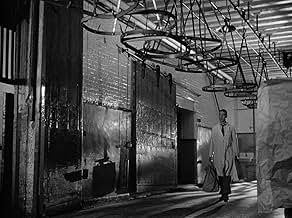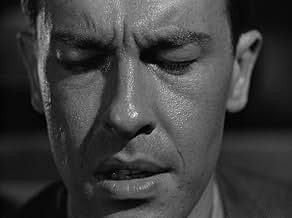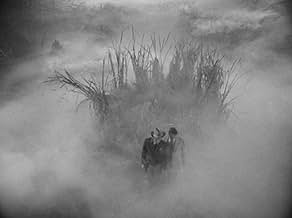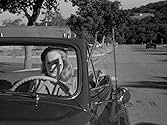NOTE IMDb
7,6/10
16 k
MA NOTE
Ajouter une intrigue dans votre langueTwo disturbed young people release their fascination with guns through a crime spree.Two disturbed young people release their fascination with guns through a crime spree.Two disturbed young people release their fascination with guns through a crime spree.
- Réalisation
- Scénario
- Casting principal
- Récompenses
- 1 victoire au total
Russ Tamblyn
- Bart Tare (age 14)
- (as Rusty Tamblyn)
David Bair
- Dave Allister (child)
- (as Dave Bair)
Frances Irvin
- Danceland Singer
- (as Frances Irwin)
Avis à la une
Peggy Cummins is the epitome of the bad dame.....in a word, terrific. The casting of this British actress was probably chancy for director Lewis but he hit paydirt. She comes across as a woman who wants it all and doesn't care how she gets it. Besides, she like to kill and wants to do "Just one more job." The choice of John Dall for the male lead was even more chancy. Dall, a stage actor, certainly wasn't very masculine and his acting revealed his stage background. But, again, Lewis hit the jackpot since it made the control that Cummins had over him even more believable.
The story has already been discussed on these boards so I won't repeat it except to say that it moves along at a rapid pace and keeps you enthralled from the beginning (well, not quite. Forget the sappy prologue and get right to the story.) A lot has been said about the one shot (from the back seat of the car) bank robbery but it is dynamite. It is said that Dall and Cummins' dialogue is improvised and that when you hear someone shout" The bank has been robbed", it is an actual pedestrian who did not know that a movie was being made. Now that's realism.
This little B thriller is as good as it gets and belongs right up there with "Detour", the gem of low-budget films. Enjoy!!!!!!!!!
The story has already been discussed on these boards so I won't repeat it except to say that it moves along at a rapid pace and keeps you enthralled from the beginning (well, not quite. Forget the sappy prologue and get right to the story.) A lot has been said about the one shot (from the back seat of the car) bank robbery but it is dynamite. It is said that Dall and Cummins' dialogue is improvised and that when you hear someone shout" The bank has been robbed", it is an actual pedestrian who did not know that a movie was being made. Now that's realism.
This little B thriller is as good as it gets and belongs right up there with "Detour", the gem of low-budget films. Enjoy!!!!!!!!!
I had heard a lot about this when I first discovered "film noir," and I was not disappointed. It was very entertaining. I still enjoy watching this periodically, even after a half-dozen viewings.
John Dall and Peggy Cummins make one of the more interesting male-female pairings I've ever seen on film. Cummins is one of the prettiest women I've seen from the noir era and fascinating to view throughout this movie. I'm sorry her other films aren't on video. She didn't do many movies in the U.S.
The character Dall plays is good, too, although in the end his constant whining over the predicament he got into gets a little annoying. He plays the nice guy who is led astray by the bad woman. Yes, another classic example of the old Rabbinic saying that "a bad woman will always drag down a good man."
Innovative camera-work also make this fun to watch. At just under an hour-and- a-half, this is a fast-moving, always-entertaining film noir that lives up to its hype.
John Dall and Peggy Cummins make one of the more interesting male-female pairings I've ever seen on film. Cummins is one of the prettiest women I've seen from the noir era and fascinating to view throughout this movie. I'm sorry her other films aren't on video. She didn't do many movies in the U.S.
The character Dall plays is good, too, although in the end his constant whining over the predicament he got into gets a little annoying. He plays the nice guy who is led astray by the bad woman. Yes, another classic example of the old Rabbinic saying that "a bad woman will always drag down a good man."
Innovative camera-work also make this fun to watch. At just under an hour-and- a-half, this is a fast-moving, always-entertaining film noir that lives up to its hype.
Sharpshooters Ben Tare and Annie Laurie Starr, fall in love at a carnival sideshow, marry soon after and hope for a peaceful married life. When the money runs out Annie tells Ben that using the guns for nefarious purposes will the only way for them to survive. While placid Ben agrees to the proposal, trigger happy Annie soon gets them deeper and deeper in trouble with the law following robbery after robbery, stickup after stickup, until it becomes kill or be killed. Very daring and overlooked film, rises above the status of the B movie genre to which this film is delegated to. Cummins is perfect as the gun-crazed, as well the love-hungry Annie. Great cinematography by Russell Harlan, shooting all of the bank holdups from the back seat of the couple's car, making the audience feel a part of the getaway. Rating, 9 of 10
At the time, such an idea of having the heroes being the criminals was un-heard of, but Joseph H. Lewis's film deservedly has its claim of being the little B-movie that could (forgive the mechanical analogy) by inspiring the French new-wave and other films like Bonnie & Clyde. The idea of having a tragic love story pitted in the middle of noir facade was also seen in the equally powerful low-budget They Live by Night. But while Nicholas Ray's film is more impressive on its emotional stakes, Gun Crazy rakes up points for some of its technical achievements. The style implemented by Lewis and DP Russel Harlan (also responsible for the great photography in Red River) adds excitement to the more suspenseful, even violent scenes, and adds some sentiment to the softer ones involving the couple. And I love the scenes where young Bart can't seem to put away his fascination with guns.
Bart (John Dall) starts off as a boy, and in some of these early scenes (some of the best in the film), we see how he is changed by an unfortunate act, and then the story skips ahead suddenly. Now Bart is an adult, out of the army, and gets re-introduced to guns once he meets his soon-to-be love and partner in crime, Annie, played by Peggy Cummins. From there, after getting married and needing (or rather wanting) money, they start robbing banks across country, but soon to meet their demise. But more than anything, the film's focus isn't one where 'crime doesn't pay' or some kind of typical, of-the-period nonsense. Like the Asphalt Jungle, we're given these conflicted, emotional beings who may meet their own ends with each other before the law. And in the film-noir tradition, it's the woman here who will act as a main catalyst for the end of them. It's psychological side of danger, pathological lies, and the pattern of a downward spiral in having to commit violent acts (even un-intentionally), becomes what really pulls in the viewer into the picture, aside from the more loose, on-location 'real' style and interesting camera-work.
Under more 'B-movie' conditions, Lewis sneaks in plenty of chances to look past some of the more cardboard cut-out forms the characters could have been. The acting by the leads is also very good, the script mostly by Dalton Trumbo is one of his best, and both understand how one reflects the other. Cummins is perfect in her part, even if Dall isn't quite as much a stand-out (though, of course, he's the sap to her more wicked side). Also out of the script comes cool lines like the one listed in the summary. It's a notch above many other B-noirs of the period, and should be seen by most serious fans of the 'mood' that came in noir films. A bit cynical, fatalistic to be sure, but it's smart too.
Bart (John Dall) starts off as a boy, and in some of these early scenes (some of the best in the film), we see how he is changed by an unfortunate act, and then the story skips ahead suddenly. Now Bart is an adult, out of the army, and gets re-introduced to guns once he meets his soon-to-be love and partner in crime, Annie, played by Peggy Cummins. From there, after getting married and needing (or rather wanting) money, they start robbing banks across country, but soon to meet their demise. But more than anything, the film's focus isn't one where 'crime doesn't pay' or some kind of typical, of-the-period nonsense. Like the Asphalt Jungle, we're given these conflicted, emotional beings who may meet their own ends with each other before the law. And in the film-noir tradition, it's the woman here who will act as a main catalyst for the end of them. It's psychological side of danger, pathological lies, and the pattern of a downward spiral in having to commit violent acts (even un-intentionally), becomes what really pulls in the viewer into the picture, aside from the more loose, on-location 'real' style and interesting camera-work.
Under more 'B-movie' conditions, Lewis sneaks in plenty of chances to look past some of the more cardboard cut-out forms the characters could have been. The acting by the leads is also very good, the script mostly by Dalton Trumbo is one of his best, and both understand how one reflects the other. Cummins is perfect in her part, even if Dall isn't quite as much a stand-out (though, of course, he's the sap to her more wicked side). Also out of the script comes cool lines like the one listed in the summary. It's a notch above many other B-noirs of the period, and should be seen by most serious fans of the 'mood' that came in noir films. A bit cynical, fatalistic to be sure, but it's smart too.
Gun Crazy (1950)
The clumsy original title, Deadly is the Female, is surely accurate. Boy was Peggy Cummins perfect in this role, and it's odd she did little else with her career. She's no searing dame as in other noirs, but she's a kind of regular, cute girl who attracts not men, but one particular man, played by John Dall. Dall is a perfect victim. He plays the innocent ordinary American guy perfectly, better than even a James Stewart because he has no charisma, no ability to inspire those around him.
So Annie and Bart form a pair of misfits who fit together. And they both love guns, and are really really good with them.
The plot is pretty straight forward from here, but it's fast, and photographed with more vigor than most better films. The dialog pushes the artifice of noir-speak a bit hard, but I swallow it whole and love it as style. And besides, these are two unsophisticated people who might just talk a little corny and dramatic at times. And Annie is truly unpredictable, and her ups and downs are a thrill for us as much as a worry for poor Bart.
Yes, a femme fatale and a noir hero, isolated and doomed. And some riveting long take photography including the now legendary camera view from the back seat of a car, on and on, and on, showing them driving, getting out, waiting while they rob a bank, swerving out a little to look out the window, pulling back, and following them on their escape. It's about as good as B-movie camera-work innovation gets. Cinematographer Russell Harlan was an A-movie quality guy from the studios, later to do "Witness for the Prosecution" and "To Kill a Mockingbird." The angles, the close-ups on their sweaty faces, the moving camera. Check it out.
This is a great movie, in all. Legendary for many reasons. It has flaws if you want to see them that way. Or it has all the raw energy of a scrappy fighter who is determined to win, and does.
The clumsy original title, Deadly is the Female, is surely accurate. Boy was Peggy Cummins perfect in this role, and it's odd she did little else with her career. She's no searing dame as in other noirs, but she's a kind of regular, cute girl who attracts not men, but one particular man, played by John Dall. Dall is a perfect victim. He plays the innocent ordinary American guy perfectly, better than even a James Stewart because he has no charisma, no ability to inspire those around him.
So Annie and Bart form a pair of misfits who fit together. And they both love guns, and are really really good with them.
The plot is pretty straight forward from here, but it's fast, and photographed with more vigor than most better films. The dialog pushes the artifice of noir-speak a bit hard, but I swallow it whole and love it as style. And besides, these are two unsophisticated people who might just talk a little corny and dramatic at times. And Annie is truly unpredictable, and her ups and downs are a thrill for us as much as a worry for poor Bart.
Yes, a femme fatale and a noir hero, isolated and doomed. And some riveting long take photography including the now legendary camera view from the back seat of a car, on and on, and on, showing them driving, getting out, waiting while they rob a bank, swerving out a little to look out the window, pulling back, and following them on their escape. It's about as good as B-movie camera-work innovation gets. Cinematographer Russell Harlan was an A-movie quality guy from the studios, later to do "Witness for the Prosecution" and "To Kill a Mockingbird." The angles, the close-ups on their sweaty faces, the moving camera. Check it out.
This is a great movie, in all. Legendary for many reasons. It has flaws if you want to see them that way. Or it has all the raw energy of a scrappy fighter who is determined to win, and does.
Le saviez-vous
- AnecdotesThe bank heist sequence was done entirely in one take, with no one other than the principal actors and people inside the bank aware that a movie was being filmed. When John Dall as Bart Tare says, "I hope we find a parking space," he really meant it, as there was no guarantee that there would be one. In addition, at the end of the sequence someone in the background screams that there's been a bank robbery - this was a bystander who saw the filming and assumed the worst.
- GaffesAnyone who has done even a little mountain hiking knows that alpine marshes and swamps are quite common, especially in California. All it takes is a shallow depression that fills seasonally with snow melt. Many (not all) alpine lakes have adjacent marshy areas. There is no suggestion in the film that the protagonists are at an altitude sufficient for permanent snow cover. Consequently, movement into a marshy area for the final scene is not a goof in any sense.
- ConnexionsEdited into Chasse au gang (1953)
Meilleurs choix
Connectez-vous pour évaluer et suivre la liste de favoris afin de recevoir des recommandations personnalisées
- How long is Gun Crazy?Alimenté par Alexa
Détails
- Date de sortie
- Pays d’origine
- Sites officiels
- Langue
- Aussi connu sous le nom de
- Le démon des armes
- Lieux de tournage
- 2300 E Olympic Blvd, Los Angeles, Californie, États-Unis(Armour meatpacking plant)
- Sociétés de production
- Voir plus de crédits d'entreprise sur IMDbPro
Box-office
- Budget
- 400 000 $US (estimé)
- Montant brut mondial
- 17 322 $US
- Durée
- 1h 27min(87 min)
- Couleur
- Rapport de forme
- 1.37 : 1
Contribuer à cette page
Suggérer une modification ou ajouter du contenu manquant


































